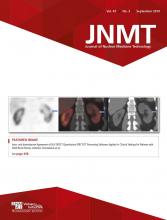Mark H. Crosthwaite, CNMT, FSNMMI-TS
Over the last year I have had the opportunity to visit several chapters, and I would like to thank you all for your gracious hospitality. Thanks also to our friends in Australia, where I had the opportunity to attend the annual meeting of the Australia and New Zealand Society of Nuclear Medicine (ANZSNM). During these travels, I had the chance to share many ideas, have many enjoyable conversations, and attended numerous hours of continuing education. One prevailing theme echoed at every meeting: targeted therapy—or, to use the new buzzword, theranostics.
In the United States, most therapy lectures relate to the application of DOTATATE and its association with 68Ga and 177Lu. I heard about this at every chapter meeting. Exciting! However, when I was outside the country, I heard about targeted therapies extending far beyond 68Ga-DOTATATE and 177Lu-DOTATATE. For example, clinical research in Australia has “promising results” in the treatment of prostate cancer with the application of 177Lu-PMSA (1). In India there are ongoing clinical trials using α-particles, particularly with 225Ac-DOTATATE used to treat certain forms of neuroendocrine cancers (2). In Germany, 225Ac-PMSA is being used to treat prostate cancer (3).
When I asked our friends from down under, Is there an advantage of using α-therapy over β?, I was told that α-radiation is less toxic and does not travel very far, and the therapeutic dose is as much as 100-fold greater. Therefore, it appears we will be seeing more α-particle therapy in the near future.
How should SNMMI-TS respond to this? It appears that, once again, nuclear medicine has great opportunity to expand into new areas. Are we ready?
My focus as president will be to start a new Task Force on Molecular Therapy. James Crowley, CNMT, will be chairing the committee, and Seyed Mohammadi, CNMT, will be vice chair. The three main goals of the task force are:
To keep radiotherapy in nuclear medicine, so nuclear medicine technologists will be the ones performing it.
To keep nuclear medicine technologists informed with publications, including continuing education articles, and to develop a SNMMI Targeted Therapy portal.
To promote radiotherapy to other physicians, patients, and the general public.
I leave you with one final thought. I have seen nuclear medicine evolve over the years, but I have also seen parts of the profession being taken away from us—brain imaging to CT, cardiac imaging to cardiologists, nuclear magnetic resonance (NMR) to magnetic resonance (MR), in-house radiopharmacy to unit doses. So, what about targeted therapies? I know that some oncologists are interested in bringing this into their practices. My goal is to keep this within our field of practice, and with the assistance of the Society of Nuclear Medicine and Molecular Imaging and our Molecular Therapy Task Force, we will. If you have any thoughts on this matter, you are welcome to contact me at mhcrosthwait{at}vcu.edu.








